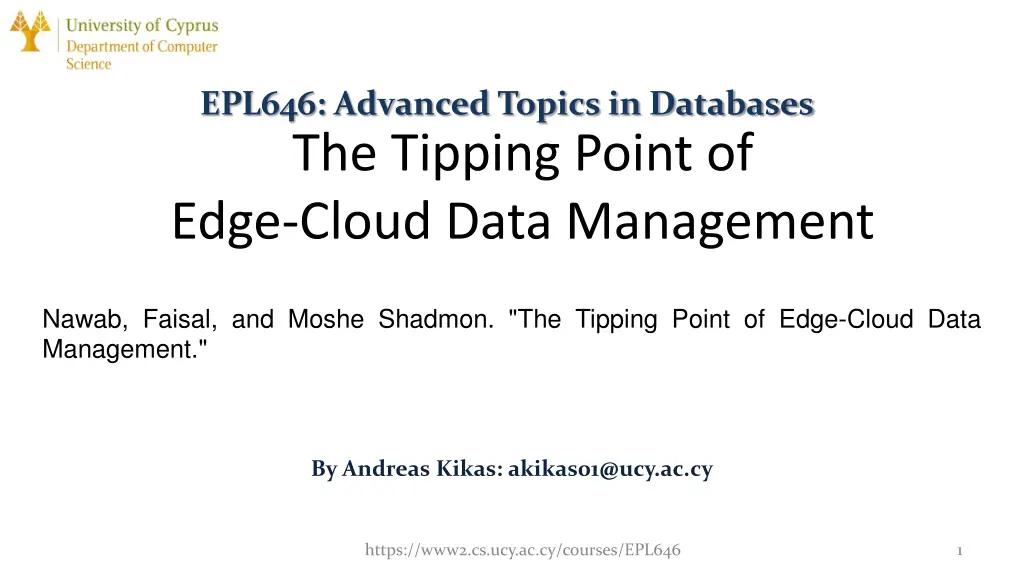
Edge-Cloud Data Management: The Tipping Point
"Learn about the challenges and solutions in managing data for IoT and edge applications with a focus on edge-cloud databases in the article 'The Tipping Point of Edge-Cloud Data Management.' Explore how a distributed and decentralized approach can enhance latency and communication while discussing the development of AnyLog as an edge-cloud database solution."
Download Presentation

Please find below an Image/Link to download the presentation.
The content on the website is provided AS IS for your information and personal use only. It may not be sold, licensed, or shared on other websites without obtaining consent from the author. If you encounter any issues during the download, it is possible that the publisher has removed the file from their server.
You are allowed to download the files provided on this website for personal or commercial use, subject to the condition that they are used lawfully. All files are the property of their respective owners.
The content on the website is provided AS IS for your information and personal use only. It may not be sold, licensed, or shared on other websites without obtaining consent from the author.
E N D
Presentation Transcript
EPL646: Advanced Topics in Databases The Tipping Point of Edge-Cloud Data Management Nawab, Faisal, and Moshe Shadmon. "The Tipping Point of Edge-Cloud Data Management." By Andreas Kikas: akikas01@ucy.ac.cy 1 https://www2.cs.ucy.ac.cy/courses/EPL646
Introduction IoT and edge applications are based on gadgets like wearables, PLCs, sensors, and smartphones, and they have a wide range of applications, from customized healthcare and immersive gaming to smart cities. For these applications to be deployed successfully, an effective data infrastructure is required because they usually have low latency requirements, irregular connection, and produce massive amounts of continuous data. Current approaches frequently use centralized paradigms, which may not be able to handle edge-cloud databases sufficiently because of latency and connection problems. This might result in data silos and proprietary software stacks. https://www2.cs.ucy.ac.cy/courses/EPL646 2
Introduction In order to achieve low latency and smooth communication, the article promotes a distributed and decentralized edge-cloud database design, highlighting the significance of being close to consumers and IoT/edge devices. https://www2.cs.ucy.ac.cy/courses/EPL646 3
Introduction The article describes the authors' five-year journey investigating and creating edge-cloud databases from both corporate and academic viewpoints. This trip resulted in the development of AnyLog and the investigation of several important elements of data management in this particular context. https://www2.cs.ucy.ac.cy/courses/EPL646 4
ANYLOG: AN EDGE-CLOUD DATABASE By efficiently extending cloud computing and data management features to Edge resources, AnyLog aims to streamline the scaling and administration of Edge data infrastructure. The data layer and the coordination layer are the two layers in which AnyLog functions. With connections to well-known databases like PostgreSQL and MongoDB, the data layer offers local database features linked with higher layers, such as a rule engine. Configuring services from an integrated stack simplifies AnyLog deployment and eliminates the need for proprietary solutions or the integration of disparate functions. On every AnyLog node, users have the ability to enable different services, including rule engine functions, security, authentication, and data intake. https://www2.cs.ucy.ac.cy/courses/EPL646 5
ANYLOG: AN EDGE-CLOUD DATABASE To ensure consistency between member nodes, the coordination layer keeps a decentralized ledger of meta-information and system settings. Access control, data mappings, node memberships, and data propagation details are all included in this. AnyLog implements two fundamental design concepts: resource virtualization through fluid virtual nodes, where dispersed resources are handled as a single entity, and data virtualization through virtual tables, where distributed data appears as a cohesive collection. https://www2.cs.ucy.ac.cy/courses/EPL646 6
ANYLOG: AN EDGE-CLOUD DATABASE Users engage with a collection of virtual tables, with the data remaining dispersed and housed in Edge node local databases. Nodes holding pertinent data respond to queries to virtual tables, giving users and apps a consistent picture. With AnyLog, several physical nodes may be represented by a single "virtual" node, making it possible to manage dispersed resources. This enables users to make a single call to query and track the status of several devices. AnyLog wants to make the Edge environment as user-friendly as the Cloud by centralizing the administration of dispersed data and resources. Applications may handle resources and query databases similarly to centralized databases, which improves usability and productivity. https://www2.cs.ucy.ac.cy/courses/EPL646 7
ANYLOG: AN EDGE-CLOUD DATABASE Users may effectively manage and monitor Edge resources based on several criteria by dynamically querying shared metadata for certain profiles of nodes and combining metadata replies with queries for specified states. AnyLog's method simplifies processes and improves accessibility and usability by equating Edge data administration with managing data in centralized or cloud-based databases. https://www2.cs.ucy.ac.cy/courses/EPL646 8
ANYLOG: AN EDGE-CLOUD DATABASE https://www2.cs.ucy.ac.cy/courses/EPL646 9
KEY DIFFERENCES TO EXISTING TECHNOLOGIES Unlike other centralized, distributed, and cloud-based solutions, AnyLog's edge-cloud architecture places a strong emphasis on decentralization. AnyLog differs from distributed databases such as CockroachDB, Spanner, and CosmosDB in that it prioritizes data decentralization above data partitioning. AnyLog nodes are capable of hosting any kind of data item, preserving data at the source where it is created. Since new nodes join or leave the network on a regular basis, the dynamic nature of edge data management is supported without necessitating constant data redistribution. https://www2.cs.ucy.ac.cy/courses/EPL646 10
KEY DIFFERENCES TO EXISTING TECHNOLOGIES AnyLog allows resource decentralization and scales to a large number of nodes. Only a fraction of the nodes that are relevant to the query are processed, enabling high parallelism and effective resource usage. In order to reduce overhead and data transfer, functions are shifted to edge nodes wherever feasible. The system expands horizontally by dynamically adding nodes. AnyLog unifies many separate local databases and presents them as a single edge machine. It controls edge resources and dispersed data, including disk, networking, and access statistics. https://www2.cs.ucy.ac.cy/courses/EPL646 11
KEY DIFFERENCES TO EXISTING TECHNOLOGIES All remote nodes rely on shared metadata as a central control point to maintain uniform network settings and regulations. Every AnyLog node has a rule engine that may act on resource and data states, and it provides Pub-Sub and REST APIs for interacting with applications and data sources. https://www2.cs.ucy.ac.cy/courses/EPL646 12
KEY DIFFERENCES TO EXISTING TECHNOLOGIES In addition to handling dispersed data, the platform offers features for edge resource management, performance optimization, and easy application integration. Scalability and flexibility in edge contexts are made possible by AnyLog's design, which leverages decentralization, resource distribution, and centralized control mechanisms to allow efficient edge computing. https://www2.cs.ucy.ac.cy/courses/EPL646 13
ANYLOG FUNCTIONALITY SHOWCASE The primary features of AnyLog are demonstrated, emphasizing how it differs from conventional distributed databases in important ways and focusing on data and resource virtualization. The shared information is made up of JSON scripts, or policies, that are kept on the blockchain. This allows for uniform policy availability between participating nodes, regardless of where they came from. https://www2.cs.ucy.ac.cy/courses/EPL646 14
ANYLOG FUNCTIONALITY SHOWCASE Users can designate the preferred physical database for each node, using PostgreSQL, SQLite, and MongoDB depending on needs. AnyLog data is stored in local databases on participating nodes. AnyLog provides a high-level programming language that may be used to map ingested data to target structures or schemas, increasing adaptability and facilitating integration with different device APIs. Using a REST interface, user requests, instructions, and queries are delivered to AnyLog nodes. The receiving node then serves as an orchestrator, forwarding requests to the appropriate peer nodes. https://www2.cs.ucy.ac.cy/courses/EPL646 15
ANYLOG FUNCTIONALITY SHOWCASE The suggested demo structure uses a video analytics program for traffic control to show the benefits and problems in edge-cloud data management using AnyLog. https://www2.cs.ucy.ac.cy/courses/EPL646 16
ANYLOG FUNCTIONALITY SHOWCASE A crucial feature is the introduction of virtual tables, which enable table browsing throughout the network and query issuing without requiring knowledge of the nodes hosting the data. Video segments are kept in real time using an object database on local nodes and are available through the AnyLog client interface, as an example of multimedia data management. https://www2.cs.ucy.ac.cy/courses/EPL646 17
ANYLOG FUNCTIONALITY SHOWCASE The demo also shows how AnyLog is decentralized, how to add nodes to the network seamlessly, and how to coordinate actions without requiring external dependencies or redistributing data. https://www2.cs.ucy.ac.cy/courses/EPL646 18
Conclusion AnyLog provides a uniform stack that substitutes enabled services on edge nodes for engineering efforts, simplifying the implementation of edge computing. Because of the way its protocol handles decentralized data, it can be integrated and managed with ease. https://www2.cs.ucy.ac.cy/courses/EPL646 19
Conclusion AnyLog improves efficiency and scalability by treating and monitoring edge resources as a single, integrated unit. With no negative effects of centralization, the platform offers low-latency access to AI processes and applications by scaling horizontally to handle data growth at the edge. https://www2.cs.ucy.ac.cy/courses/EPL646 20
Thank you! https://www2.cs.ucy.ac.cy/courses/EPL646 21






















